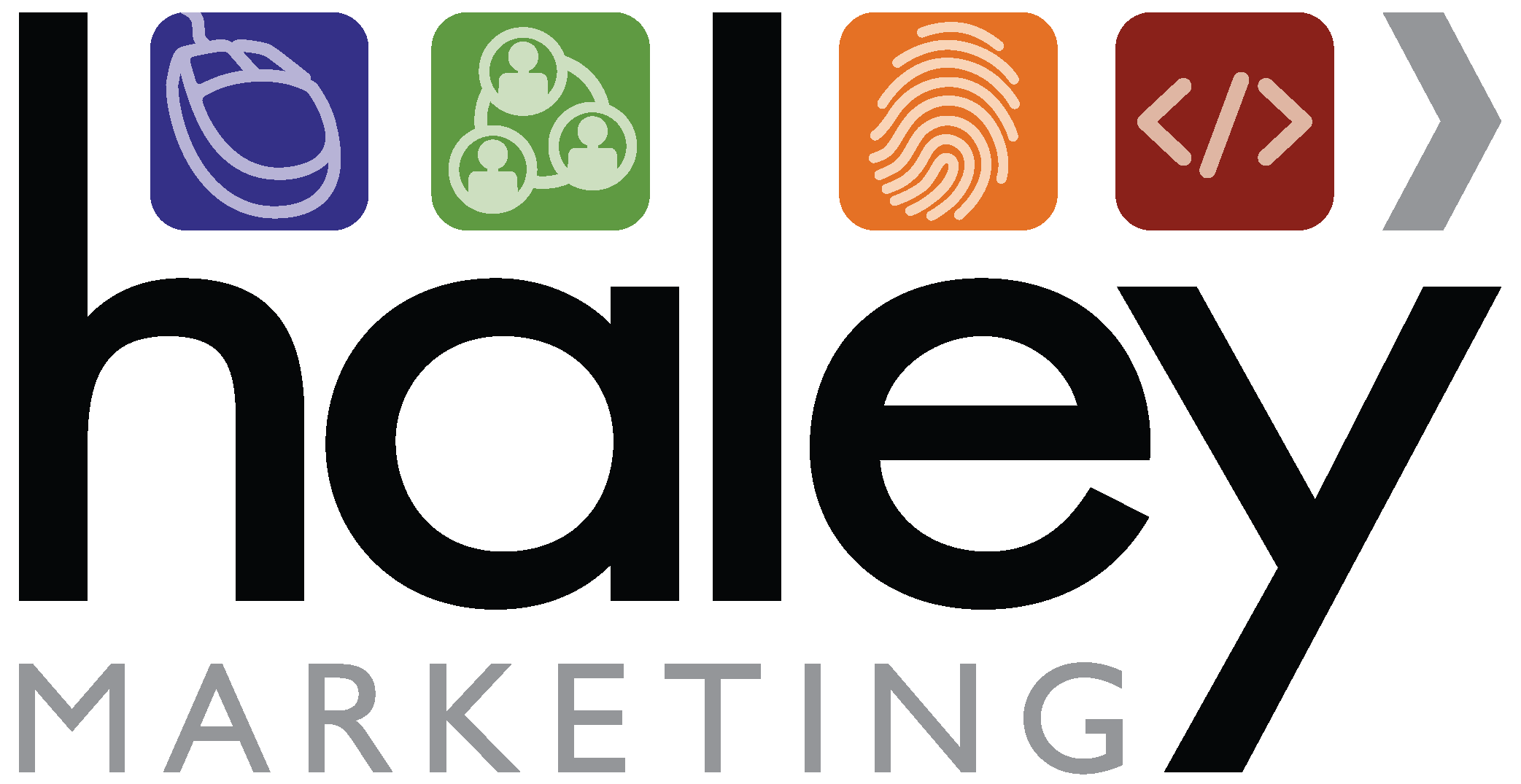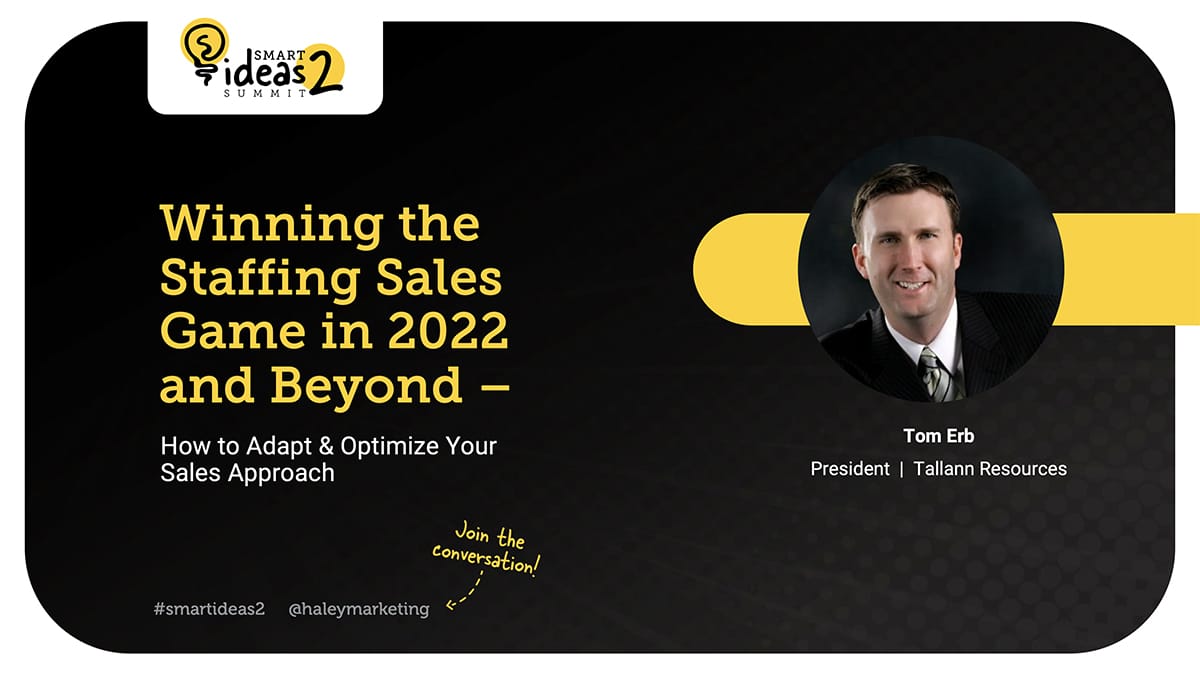Thanks to everyone who joined us for SMART IDEAS Summit 2. We’ve been getting awesome feedback from the attendees!
If you were not able to make it or missed a session or two, you’ll be happy to hear:
The SMART IDEAS Summit 2 Content Is Available on Demand!
Find the free recordings and slides for 14 educational presentations from some of the smartest minds in staffing here. Just enter your contact information for access, and then click on any recordings you are interested to watch when it’s convenient for you!
Session Recap: Winning the Staffing Sales Game in 2022 and Beyond – How to Adapt & Optimize Your Sales Approach
Video Transcript
In this session, Tom Erb talks to us about sales.
For the last couple of years, the focus has been on recruiting. But as we go through this recession (or non-recession, or yes, it’s both), we’re getting more and more questions about sales.
Never Stop Selling
One of the challenges on the recruiting side is that we don’t sell enough. And when we don’t sell enough, we end up working with clients that aren’t great and orders that aren’t that great. One of the best ways to improve your recruiting is to sell more to bring in better clients and better orders.
I wrote the book Winning the Staffing Sales Game almost five years ago, in 2017. And I am asked all the time, is it still relevant? Is it still the way that we should be doing things?
I would say it’s even more relevant to how people buy and work now. We’ve learned a lot over the last several years and made some edits to the book, but it is still a very compelling and effective way of selling.
Selling Has Radically Changed
Selling was already starting to change, and the pandemic made a big difference. Many decision-makers are still not in the office or not in the office full-time. They may never come back to the office. That changes the way we sell. The pandemic has also changed the way everybody works and buys.
It’s impacted the way we interact with prospects. And we’re all communicating differently. Three years ago, I couldn’t get one of my clients to talk on a video call. And now, if I just have a regular phone call, it feels weird. And I think most people would agree that we’re all communicating in different ways. That impacts sales.
How Has The Sales Environment Changed?
Prospects are becoming even harder to get in front of. It’s harder to get them on the phone. Networking is coming back in fits and starts. But in many cases, particularly HR conferences have not come back. In-person cold calls were never really welcome and are even less welcome now because of the pandemic and the fears people continue to have. Also, people have just gotten out of the habit of meeting in person. Sales reps have, and our prospects have, too.
Shift Toward Informational Buying
Decision-makers have more information and ways to get information than ever through the internet, social media, mailings, and all sorts of different ways. Marketing has become even more interwoven with sales. It used to be marketing was over here, and sales was over here, and they interacted some. Now they mesh together.
Has Your Sales Approach Adapted To The Change?
Our sales activities need to be more purposeful. We can’t just shotgun our approach. We need to be more targeted and consistent. Daniel Pink is probably one of my favorite non-fiction business writers. In his book, To Sell Is Human, he discusses the informational buyer. “The balance of power has shifted, and how we’ve moved from a world of caveat emptor, which is buyer beware,” we’ve all heard of that, “to one of caveat venditor, which is seller beware, where honesty, fairness, and transparency are often the only viable path.” Buyers are more informed than ever before. But this is a good thing. We can leverage this and adapt our selling process to benefit from this informational buyer.
Provide Buyers With Proof
As honest, ethical and credible as we are, our buyers still look at us suspiciously because our ultimate goal is to get them as a client. In most cases, they’ve been burnt before by sellers who haven’t been as honest and ethical as we are. To make up for that, we must provide proof through content, our website, online reputation, social media, testimonials, case studies, references, and video testimonials. These reinforce what we’re saying is true. We’re accustomed to Zoom and Teams calls. We have seen success with video embedded in emails, video testimonials and video appointments. How can we use video in our day-to-day sales process?
Go Where Your Competitors Are Not
Anytime most of your competition moves away from something, there is opportunity. I get pushback all the time, and I guarantee there are people on this call right now thinking, really? Mail? That’s why you have to do it; because your competitors are not using mail as they should be. Social media is saturated, but there are still all sorts of opportunities to leverage social media as well as email and phone calls.
Consider Sales A Game Of Chess, Not War
The Game of War is a card game. You have a deck of cards you split in half. The two players slap cards down face up. The high card wins. It’s very transactional. There’s no strategy. It has a winner and a loser. It’s a game of luck. Chess is a game of strategy. You can’t win on the first move, but you can set yourself up for each subsequent move. If you’re really good at chess, you’re thinking two, three, four, or five moves down the road, as well as what the other player is going to do. Like chess, sales is a process. We can’t be just look at it as a transactional event.
Why Are You Making Calls?
When I ask the question, “what is your objective when you make a cold call,” the number one answer I hear is getting an appointment. Number two is getting an order. Number three is building rapport, and finding out information. But when I ask, “what usually happens when you make a cold call,” they say, “I get their voicemail.” Nobody has ever said, “I want to leave a compelling voicemail that is going to position me for the next step that I take.” But that’s really what we need to think about.
Expect to Make Multiple Calls
We’re not going to win the whole thing in one phone call. In fact, twenty-two out of twenty-three times, we’re going to get a voicemail. What we need to do instead is think about each part of it as a process that builds upon itself rather than being a series of unrelated transactions, as most sales activity is. That’s why we need to look at sales as a game of chess and not war.
Implement A Structured Multi-Touch Sales Process
Nothing I want to talk about today is revolutionary. It’s what we used to do. We got away from it for a lot of different reasons. One, sales was much easier for a long period of time. And in some cases, it still is. And we’ve learned to leverage email and things like that. But what we want to do is take the types of activities that we need to do to be successful in sales and create structure and process around it. So, let’s walk through this at a high level.
Level One: Suspect
Most people look at prospects, everybody’s a prospect, or everybody’s a lead. And that is a general large bucket. But when we look at prospects, there are three levels. There are suspects, which are prospects we haven’t yet qualified, but looks like they would be a type of company or a type of contact that we would work with, but we haven’t yet qualified them yet. We haven’t had a conversation with them. We don’t know for sure if they actually use staffing or if they would be open to using us.
Level Two: Prospect
A prospect is your traditional qualified prospect. We know they use staffing, but right now they’re not interested in talking to us. They got five other providers. They don’t want to add a sixth to replace one. we need to just keep in touch with them.
Level Three: Target
Targets are the companies that actually not only do we know use staffing, but they have opened the door to potentially us working with them, even if that’s slight. And if you think of it in another way, a suspect is cold, a prospect is warm, and targets are hot. The first thing we do is identify these suspect companies and contacts. What’s our ideal profile for a client? And then we go and find those people. And then we put them into a multi-touch process, a prospecting process.
Structured Qualification Process
We have a 10-week process that we’ll talk through. Then we go through, and we disqualify and qualify prospects. It’s equally important to disqualify the ones we shouldn’t spend our time on as it is to home in on the ones that are qualified and become prospects and, in some cases, targets. We have these targets, which means we have opportunities to do business with them. We add them to our sales pipeline, and then we start to work through that sales process. We’re working through the stages of the sales process. And then ultimately, once they’ve gone through that, we close them out as wins and losses, and we’re constantly feeding the sales process. This is a circle. This is not a straight line. This is a circle. We’re constantly feeding it that we are replenishing who we’re going after. So, that’s a high level of it. Let’s get into a little more detail about some specifics around this.
Difference Between Sales Success And Sales Failure
Before we discuss that, another question I get on a regular basis is, what’s the difference between sales success and sales failure? And I always answer it the same way, but over the course of time, I said, you know what? It really fits into this acronym MVP. And before we can get to that, what we really have to do is create a baseline. If we don’t have three things, it’s very difficult for us to be consistently successful. And I would say that these all tie into the EQ or emotional quotient of the salesperson.
Salesperson EQ
We need to be likable; we need to be credible, and we need to be coachable. If I have somebody that is likable, credible, and coachable but doesn’t have any experience, I will take that – 10 times out of 10, over somebody that has 20 years of staffing sales experience but isn’t likable, credible or coachable, or is missing one of those things. So, that’s our baseline. In order for us to be successful, we need to be likable, credible, and coachable.
Differentiating Messaging
Above that, what we need to do is have the right type of messaging. We have to have messaging that differentiates us, truly differentiates us from our competition. Messaging is the first thing.
Volume And Variety
We need to reach out to enough people to have enough volume and reach out to enough of these suspects and prospects to give ourselves a chance at success. But the other thing we need to do is have enough variety because we all communicate differently. Some of us have 37,000 emails unopened in our inboxes. Others haven’t checked their voicemail in two years, and you can’t even leave a voicemail. There are people that will never return an email, but they’ll return a voicemail. There are people that would never return a voicemail or even listen to it, and others that would return emails. We just don’t know. We must have enough variety of activities to hit them the way that they like to communicate.
Persistence
Not only do we need to have enough volume, reach out to enough people, and cast a wide enough net, but we must persistently reach out to them. We need to reach out to them enough to give them a chance to hear our message, to see that we’re different, to become comfortable with us, do a little research, and then ultimately for us to be able to have success. And if we think about it, it’s messaging, volume and variety, and persistence. And then on top of this emotional quotient of likable, credible, and coachable.
Structured Contact Schedule
The way that we recommend is to do a structured contact schedule. It’s 12 weeks. You can do it longer. You can do it less. The reason we do it for 12 weeks is that there’s data that shows that most sales occur between eight to twelve touches. And we got to give ourselves, we must be persistent enough, force ourselves to be persistent enough, to give ourselves a chance to be successful. Most salespeople, when I talk to them and ask them how many times they reach out to a suspect or a prospect before moving on, the most frequent answer I get is two to three times. We’re going to do it twelve times.
Mix Up Your Delivery
And we do that with a variety of different activities. We start out with a letter, and we talk about our value prop. What makes us different, why should they care? What makes us different from the other staffing companies out there and why should that matter to that suspect or prospect? In week two, we hit them three times. After we send a letter, we send an email that talks about the letter, kind of recaps it in case they didn’t have a chance to look at it. Then we say, “Hey, we’re going to reach out tomorrow between this time and this time and see if we can have some further discussion.” We call them at that time. It’s very important we do that. We’ve had prospects that have said, “I wondered if you were going to call.” they were actually testing them to make sure they were following through on what they do because quite frankly, a lot of salespeople don’t.
Follow Up Via Email
And then we do some sort of a follow-up email that could be skill marketing where we’re marketing a candidate or just a follow-up to try and get time on their calendar. Then we alternate between phone calls and emails.
Provide Valuable Content
And as David and Becca and all the others have talked throughout the day, content is what we need to be hitting them with. We need to hit them with different types of content that are of value to them. we can send them client quotes, case studies, eBooks, all these different things that we can do, and other types of content. If you don’t have a lot of content right now, just go online, do a Google search and start looking for articles that are of relevance to your prospects and send it out to them. “Hey, I thought you might be interested in this article.” Ideally, you want to get your own content, and you want to keep improving on that and keep developing it. But in the meantime, if you don’t have it, then you can look for other ways. The other easy way to get content is through client testimonials. Usually, you can round those up in a couple of days.
Qualify And Disqualify
We go through that through the 10 weeks, twelve touches. And as we’re going through this process, as we communicate with people, we’re pulling them out of the process, because this is really a process about qualifying and disqualifying. if they’re not interested in working with us, then we note that and we pick a time to follow up with them. If they do have interest, then we put them into our pipeline, and we start to work them through as a target, which brings us to this next stage of the sales pipeline.
Track The Right Metrics
There are really four areas that we look at when it comes to sales metrics and KPIs. I look at sales activities, the number of activities, which is mostly phone calls and phone call-like activities. Appointments, how many appointments do we have? What’s in our pipeline and how much do we need to have in our pipeline? And then our ultimate goal, which is gross profit or number of hours built, or the number of people on assignment. But that’s our ultimate KPI.
Focus On Pipeline
What I find with most companies is that they may have some measurements around sales activity, maybe around appointments, and maybe around gross profit or people on assignment or hours build, but in most cases, they’re missing this pipeline. And one of my clients made the analogy of flying along and suddenly going through clouds and can’t see anything. That’s kind of what it’s like if we’re missing the sales pipeline. If we don’t have visibility into companies that are in process, then we’ve got a big gap in visibility and a big gap in our path to success. we want to have a sales pipeline where we can manage this process more effectively. A lot of ATSs have opportunities to track it. If they don’t, then you can use a standalone third party. There are lots of different third-party CRMs that are out there. But even if you just do it just in a spreadsheet, it’s better than not having it at all. And we want to make sure that we have that sales pipeline going.
Closing Thoughts
In closing, just understand that our prospects and our clients are working differently. They’re buying differently. Of course, we know they’re working differently, but they’re buying differently, too. Our sales approach needs to adapt to a more structured, targeted multi-prong sales approach. We need to leverage technology to scale but also to be creative. And then we also need to increase our digital presence, use content marketing, and use other things to reinforce our credibility. that was a quick 20 minutes, but I will turn it back over to David.
Q & A With Tom Erb and David Searns
Q (David):
There were some really good questions that came in. Since we’ve got a few minutes, let’s talk about them. The first one is very practical. With everybody doing work from home, does snail mail still work?
A (Tom):
Yeah, I get this question all the time, and it’s a great question. It does. It does. It’s been two and a half years. Companies have figured out how to route mail. And what we do is we do back it off a little bit, as far as we give them a couple more business days from the time that we send the letter to the time we do the first email, just that there is a chance to route the mail or that they come in, pick up their mail for the week. But yes, it still absolutely does. And in fact, we’ve had a lot of people stop doing letters and stop doing mailings because of that very idea that people are no longer getting mail. People are still getting business mail; it just takes a little longer.
Q (David):
Yeah. We agree. Even in the heart of the pandemic, especially if you’re dealing with a decision maker with P&L responsibility, they were paying their bills, and they were getting their mail.
A (Tom):
That’s right.
Q (David):
Another really good question here. How can someone with no experience demonstrate credibility?
A (Tom):
Don’t downplay your experience level. Understand that if you’re working in the staffing industry, even if you’ve been in the staffing industry for only a few months, you have a much broader understanding of your market and the talent pool out there than they do. Whoever you’re talking to, their knowledge is limited to that one company, or maybe they came from another company; it’s limited to two. You likely have access to dozens of different companies. Don’t downplay that. That gives you expertise. I would say that’s the biggest thing. There are other things to do, but that’s the quickest.
Q (David):
Awesome, Tom. Thank you much. If you have more questions for Tom, want to know more about the sales process or want Tom’s help with improving your sales, check out his website, and reach out to him. I’ve seen Tom present lots and lots of times, and he always has great ideas to share. And I know lots of clients who are thrilled with his services. So, Tom, thank you very much.
A (Tom):
Thanks, David. Go Bills.
Want more smart ideas from the smartest minds in staffing?
Access the free recordings and slides for 14 educational presentations from the SMART IDEAS Summit 2.













